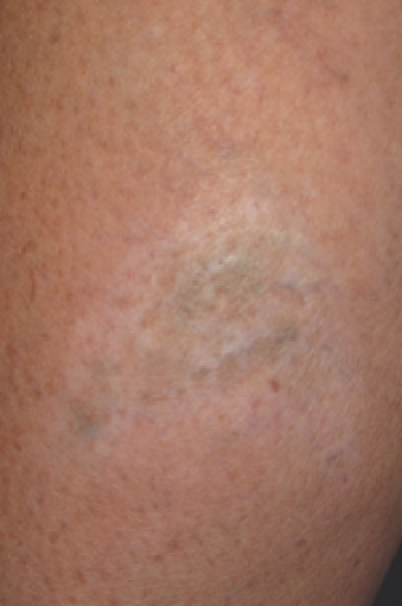Biomedical Engineering Reference
In-Depth Information
(
A
)
(
B
)
Figure 8.15
Flattening and improvement in hypopigmentation of a scar (
A
) before and (
B
) after several treatments of 1550 nm laser.
NAFL has also been studied in the treatment of striae even
though it is not approved by the FDA for this indication.
Twenty patients with striae were studied over six laser treat-
ments. Randomly chosen photos of eight patients were chosen
from the study and an independent observer rated a 26-50%
level of overall improvement in fi ve out of eight patients (44).
The 1550-nm NAFL Consensus panel recommended the set-
tings of 40 mJ, TL 10 for 8 passes in skin types I-III and TL 4-7
in darker skin types (19). When treating striae, a laser test area
is always suggested. Pre- and post-treatment with a hydroqui-
none bleaching cream is suggested in darker skin types and
areas prone to prolonged PIH, like the legs. A clinical example
of striae response to 1540 nm is shown in Figure 8.16.
6 patients with melasma (49). After 4 treatments, patients
showed 40-50% lightening of melasma and improvement was
maintained at 3-month follow-up. Another study compared
1550-nm laser resurfacing with a topical bleaching cream
through a split face study (50). The patients in the study
showed preference to the topical bleaching cream side over the
1550-nm NAFL side. The 1927-nm laser is not approved for
melasma but initial reports seem promising. An initial pilot
study by Polder et al. used the Fraxel 1927 nm in the treatment
of 18 patients with melasma (51). They performed 3-4 treat-
ments using 10-20 mJ of energy, a TL corresponding to
20-45% coverage, and 8 passes. Using the standard Melasma
Area and Severity Index (MASI) and blinded independent
photographic review of standardized photos, they reported a
51% reduction in the MASI scores at 1-month follow-up.
There was still a 33% and a 34% reduction of MASI score at
3- and 6-month follow-ups respectively. Although NAFL treat-
ment has shown success in the treatment of melasma, its long-
term effi cacy is still limited by the inherent recurrence rate of
melasma. In some patients with melasma, we have also noted
increased hyperpigmentation and prolonged erythema after
NAFL treatment. Most NAFL and other laser treatments for
melasma work best when combined with topical depigment-
ing skin care and aggressive sun protection.
Pigmentary Disorders
Increased pigmentation of the skin, as seen in photodamage
and melasma, has shown improvement through NAFL treat-
ment. Melasma can be quite distressing to patients and is
notoriously diffi cult to treat. It is a chronic skin condition seen
primarily in female patients. It presents as a brown patchy dis-
coloration over sun-exposed areas like the cheeks, forehead,
upper lip and sometimes arms. Contributing factors include
sun exposure, hormones, pregnancy, and genetics (45). Many
therapeutic modalities have been investigated over the years
but none have been shown to be uniformly successful (46,47).
When the fi rst 1550-nm laser was released, several melasma
studies were initiated. The fi rst pilot study was by Rokhsar
et al. using 1550-nm laser on 10 patients (48). It showed some
success with 60% of patients demonstrating excellent clearing
and 30% of patients demonstrating mild improvement. Vasily
used the Starlux 1540-nm laser with a 15-mm handpiece and
delivered 4 passes with 50% overlap in the treatment of
Actinic keratoses
An actinic keratosis (AK) is a precancerous, epidermal, scaly
macule or papule that occurs on sun damaged skin. Treatment
of these lesions is indicated, as there is potential for them to
progress into invasive squamous cell carcinoma. The 1550-nm
and the 1927-nm wavelengths have been studied and have
shown success in the treatment of these precancerous growths.

















